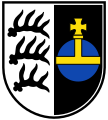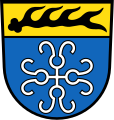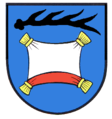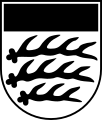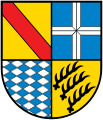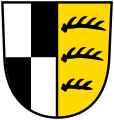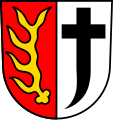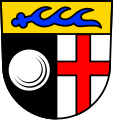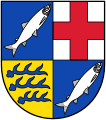Deer pole
The stag rod ( also stag horn according to Siebmacher ) is a common figure in heraldry . It is particularly well-known as a symbol of Württemberg , where it can be found in numerous municipal coats of arms. Deer sticks can also be found in the logo of the car manufacturer Porsche and the football club VfB Stuttgart .
Importance and distribution

Deer sticks were included in coats of arms for various reasons. Since deer are hunting game, a deer pole can stand as a symbol for the hunt or for game abundance (as pars pro toto ), in the more modern sense also as a symbol for intact nature. Furthermore, it can symbolize the name it stands for as a speaking coat of arms , e.g. B. with the noble family of Hirschberger ( Leutershausen an der Bergstrasse ) or with Herzlake in Emsland ( heart derived from deer ). The deer as heraldic animal in all its size has also found its way into heraldry. In Kirchhundem in the Westphalian Sauerland, accompanied by a wolf fishing rod , they also symbolize the abundance of red deer. Even places which under the hegemony of the Saxon-Bohemian noble family Bieberstein were to lead a deer pole. Blankenburg (Harz) also derives the stag rod from a local count family . In Wadern they generally stand for agriculture.
The coat of arms of Württemberg and its relatives
The coat of arms of Württemberg showed three black stag poles lying on top of each other in gold. This sign, which was first documented in the seal image in 1228, was probably adopted by the House of Württemberg at the end of the 12th century, when Count Hartmann married the heir to the Counts of Veringen . Their coat of arms also showed three stag poles, which in the first colored representation appear in 1330 in red on a golden shield. The Counts of Nellenburg , who were also linked to the Veringern , had three blue stag sticks in their coat of arms.
As the territory of Württemberg gradually expanded and the counts rose to dukes or later to kings, the Württemberg coat of arms was expanded to include additional fields, for the first time in 1447 to include the barbel of Mömpelgard . The deer stalks, regarded as the family coat of arms, retained a prominent place despite all changes, even after the end of the monarchy. In today's coat of arms of Baden-Württemberg , the stag sticks only appear in the turtle of the large state coat of arms, and a stag also serves as a shield holder.
The Württemberg deer sticks
The three stag poles also formed the coats of arms of some of the most important cities in Württemberg. B. Backnang , Sindelfingen , Tuttlingen and Waiblingen , but these cities later created a distinguishing feature for their coat of arms by choosing a different tinging or shield classification. The stag bar appeared individually as a sign of belonging to Württemberg, occasionally as the sole shield figure (for example in Göppingen or Münsingen ), but more often as an additional sign (for example Asperg , Pfullingen or Waldenbuch ). Even after Württemberg was absorbed in what is now the state of Baden-Württemberg , the stag rod appeared - now in a historicizing way - in numerous newly created municipal coats of arms, with which the communities concerned wanted to express their traditional ties with Württemberg (example: Bad Boll ). The use of a single black deer pole in a golden shield head is particularly common, e.g. B. at Kirchheim unter Teck or Freudenstadt . Usually the heraldic figure is arranged so that the horn root points to the (heraldic) right and the ends to the left; the mirror-inverted position must be specifically mentioned in the blazon, e.g. B. in the coat of arms of Albstadt . In the Tübingen coat of arms , two stag poles appear in the crest ; they form the distinguishing feature to the coat of arms of the city of Böblingen , whose shield image is the same.
A total of 90 Baden-Württemberg municipal coats of arms and eight district coats of arms feature deer sticks as a symbol of belonging to Württemberg. Outside of Baden-Württemberg, stag sticks can be found in the coats of arms of the Alsatian towns of Reichenweier and Andolsheim , which were part of the Reichenweier rule and Horburg county until the end of the 18th century , and in the short-lived coat of arms of the Lower Silesian district of Oels , in which the sidelines Württemberg-Oels was represented, and in today's coat of arms of the Polish community Pokój (German: Bad Carlsruhe, named after a duke from this sideline).
The Veringian deer sticks
The Counts of Veringen , who were mainly wealthy in the Lauchert Valley area , died out on the main line in 1415. Today the red stag sticks in the coat of arms of Veringenstadt and Langenenslingen remind of them, probably also those in the coat of arms of Gammertingen . The stag bar in the Trochtelfingen coat of arms is reminiscent of Veringen and Württemberg.
In addition, the Veringer stag sticks were represented in the former municipal coats of arms of Benzingen , Billafingen , Riedetsweiler and Veringendorf in the old district of Sigmaringen , the latter exactly corresponding to that of the Counts of Veringen.
The Nellenburg stag sticks
The Landgraviate of Nellenburg, with its headquarters in Stockach , first fell into the hands of the Lords of Tengen in the 15th century , then to Upper Austria . From 1810 it belonged to Baden. Today the blue stag sticks in the municipal coats of arms of Stockach, Eigeltingen , Gailingen am Hochrhein (in reverse colors), Mühlingen , Orsingen-Nenzingen , Steißlingen and Emmingen-Liptingen remind of the Landgraviate, as do those in the coat of arms of the district of Constance . Then there is Glattfelden (CH). The blue stag in the coat of arms of Mönchweiler ( Schwarzwald-Baar district ) is not reminiscent of Nellenburg, but of Württemberg .
See also
- List of coats of arms in Baden-Württemberg
- Coat of arms of Württemberg
- Seal of the Counts of Veringen
- List of the Burgraves of Dohna - including the coats of arms of the Burgraves of Dohna in the seals of the Burgraves and Donin's bracteates with the crossed stag sticks in the coin image







